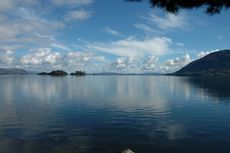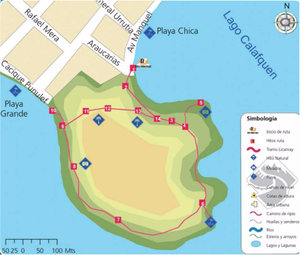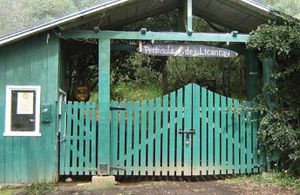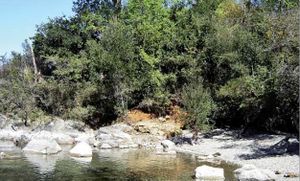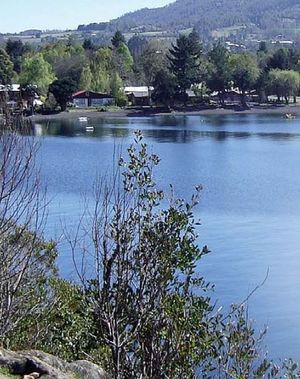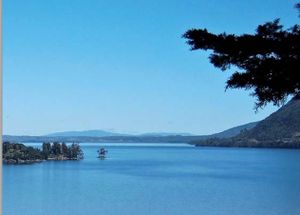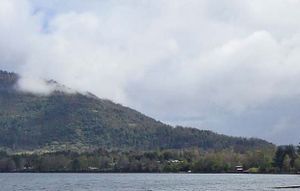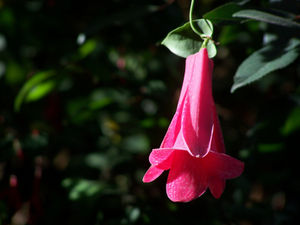ENG:Península Lican Ray
|
|
|
| |||||||||||||||||||||||||||||||||||||||||
General description
The circuit starts from the access door to the Peninsula bordering the lake to the west, where its vegetation and forests invite you to enter it. Among its attractions include: the viewpoints corresponding to Milestones No. 5 and No. 8 from which you can see the modeling of glacio-lacustrine forms in the first and a panoramic view of Lake Calafquén and its islands in the second. Likewise, three beaches will be visited along the route: at the beginning of the route, Hito N ° 1, inside the peninsula, Hito N ° 6, at the end, Playa Grande, Hito N ° 10. In all you can bathe and enjoy water activities. Throughout the tour you will find both native forest and introduced species, which can be observed with special attention in Milestones N ° 11, N ° 12 and N ° 13.
| Mapuche mitology,princess Lican Ray |
|---|
|
Princess Lican Ray The town owes its name to the legend of the young and beautiful daughter of the powerful Cacique Curilef, Princess Lican Ray, who upon the arrival of the Spaniards fell in love with one of her soldiers, provoking jealousy and going to the Mapuche people. One day the girl went to meet her lover and he promised that they would flee that night. Lican Ray warned him that if they were discovered, a horrible death awaited them both. The boys' love was stronger than the fear of death and they decided to escape together. At dusk they gathered on the banks of the lake in a canoe, silently, they went to one of the islands that seemed decked out especially for their first night of love. The cinnamon trees shone like silver in the moonlight and their white flowers swayed faintly; in the background, the volcano blew flashes that illuminated the surroundings for seconds. The lovers were two days without setting fire until, on the third day, because of the intense cold, they set a bonfire. The Mapuches who had looked for the princess in the neighboring woods, seeing the smoke on the island, decided to go there. The couple, fearing discovery, had moved to another island. In this adventure, they met a machi who had taken care of Lican Ray while she was a girl and seeing her persecuted and scared, sent a curse. Anyone who came to touch the boat where the princess and her boyfriend would be immediately transformed into an island. According to legend, this would be the reason that explains the existence of so many islands in Lake Calafquén. |
Location
The Lican Ray Peninsula Heritage Route, is located in the Araucanía, IX region of Chile, in the commune of Villarrica. Lican Ray is located on the north shore of Lake Calafquen, 113 kilometers southwest of Temuco, 24 kilometers south of Villarrica and 50 kilometers from the tourist resort of Pucón, amidst a variety of mountain landscapes generated and modeled by the retreat of glaciers and volcanic action.
Season
Given the climatic conditions of the area, it is possible to go throughout the year, although in the summer season, between the months of December and March, the conditions are more favorable for the journey of the route.
Access
The Lican Ray Peninsula Heritage Routeis located in Araucanía, Chiles RegionIX,in the borough of Villarrica. Lican Rayis on the north shore of lake Calafquén,113 kilometres south of Temuco, 24kilometres south of Villarrica and 50kilometres from the tourist resort ofPucón,and lies in the midst of a varietyof mountain landscapes created andmodelled by receding glaciers andvolcanic action.ACCESSThe route from Temuco to Lican Ray isas follows:take highway PanamericanaCH 5, and continue for twenty-sevenkilometres south until you reach theFreire crossing,where you must changeto route CH 199 and take an easterlycourse. You will reach Villarrica after 55kilometres. Lican Ray is twenty-fourkilometres south of Villarrica.On reaching Lican Ray,you must walkalong General Urrutia street until youreach the Felipe Manquel boardwalk,which takes you to Playa Chica on thelakeshore itself.The main access to thepeninsula is some 200 metres to theright.SEASONAL FEATURESWeather conditions are quite good,soyou can visit the area at any time of theyear,but the summer season (Decemberto March) has the most favourable weather for touring the route.
Road sign
The route is composed of 14 Milestones duly marked in a single circuit. This story, its milestones and signage in the field will provide information on distances, orientation, duration of the tour and attractions of the place.
The signage used for this route is divided into two types according to its function:
One. Informative or interpretive panels:are intended to provide information at the beginning of the Route, with respect to the route, distances, orientation and attractions that will be found, as well as during their journey will help to better understand the composition of the landscape and the outstanding natural aspects of a Milestone or panoramic view that appreciates.
Two. Directional beacons:They are simpler signals and are intended to clearly mark the path, so you can continue through it clearly and safely.
Route description
Milestone Nº1 - Entrance to the peninsula
To enter the Lican Ray Peninsular heritage route, you must go along General Urrutia street until you reach Playa Chica. From here you must turn to the west by Felipe Manquel street and continue 200 meters, passing the pier until you reach the access gate to the Peninsula corresponding to Milestone No. 1. In this place you will find a booth in which the registration is made during the summer season.
Hito Nº2 - Bifurcation 1 (Beacon, road indication)
Beginning the tour, you must advance along the main path. At 60 meters you will find a fork, Hito N°2 of the circuit, with a beacon that indicates the path to follow.
Milestone Nº3 - Bifurcation 2 (Beacon, indication road)
Along the same path, at 180 meters, is the Milestone No. 3 with indications to continue the road. During this part of the route you can see a forest sector of Arrayán or Palo Colorado (luma apiculata), a species that grows in areas of abundant humidity, especially on the banks of rivers and lakes. The Arrayán is an "always green" tree, that is, it keeps its leaves during all the seasons of the year, characterized by being very aromatic and by the reddish color of its wood, features that are easily distinguished.
Milestone Nº4 - Access to the lookout
50 meters further on is a signposted fork, Milestone N°4 indicating the descent and access to the viewpoint. Here you should turn left towards the lake.
| New towns, old stories | - |
At the beginning of this century, all the land that currently occupies Lican Ray was a forest of "Nothofagus oblique" in which dominated the pellín, laurel and lingue. Among the species were also cinnamon, hazel, lleuque, mañío, ulmo, tepa, among others. The historic development of Lican Ray begins with its foundation in 1942 by Don Francisco Jaramillo, who turns Lican Ray into a town, located on the ancestral lands used by an indigenous community called Loncopan. The process of colonization consisted in the free delivery of sites, reaching the population of the surroundings to be established; all of them reinforced by the installation of the company of Ferrocarriles del Estado and logging companies. In 1948 the exploitation of the forest, the main wealth of the area, ends, diminishing employment due to the exhaustion of the resource, which is why the town began to decline and people left. In 1966, to diminish migration, the government of the time defined Lican Ray as a town with a tourist vocation, selling and selling sites, with the condition of building houses and finishing their urbanization. According to the censuses, in 1960 there were 68 dwellings, in 1970 these increased to 533 and today there are between 600 and 700 houses, with an approximate population of 3,000 inhabitants. Of these two thirds are summer homes, which are only occupied during this season. In the summer homes there are several architectural styles dominating widely the constructions of wood of a single floor, varying its size and terminations. On the other hand, the houses of the residents, more modest, stand out for having intensively used orchards. |
|---|
Milestone Nº5 - Lookout of the Modelado Glaciar
At 100 meters from the fork there is Hito N ° 5 or Viewpoint of the glacial modeling. Here you can appreciate a general view of the Lican Ray, especially the Playa Chica, observing the northern sector of Lake Calafquén. In this natural viewpoint you can see the landscape of high mountains and valleys, formed by the glaciations, in a period of very long times. The last ice age began a million and a half years ago. It is in this period that the glaciers covered all the mountains and moved down the slopes, generating strong erosion. In this area, mountain summits average 1,800 m.s. The topographic relief here would have been softened by the volcanism present in the area, highlighting as the highest the Lanin volcano with 3.776 m.s.n.m.
Milestone No. 6 - Lacustrine Beach
After enjoying the beautiful view offered by the viewpoint, you can return to the main path and return to Milestone No. 4, then continue south along the same path. At 250 meters there is the sign indicating the access to the Beach Lacustre or Hito N ° 6 of the circuit. In this sector it is possible to bathe and observe the characteristics of lacustrine terraces formed by sedimentary material. The sand and sandstones of the sector, shaped by clasts or particles of rounded stones, are striking. In addition, a small rocky outcrop stands out in this sector, which, as a curiosity, presents a tree located in the rock.
From this point and in the west direction, you must go along the main path that is covered by a layer of leaves of Peninsigne (pinus radiata) that give the characteristic brown color to this sector. The pine is an introduced conifer that is found all the way through the Lican Ray Peninsula.
Milestone No. 7 - Risk zone
At 300 meters from Hito Nº6 is Hito Nº7 or Risk Zone. In this sector of the circuit, the path is narrower and it is recommended to travel this area following the path without approaching the banks, as there are steep slopes with abundant organic material loose, which gives instability to the ground.
Milestone Nº8 - Main viewpoint of the lake and its islands
200 meters further on, you must go up the same path to Hito N ° 8 or Main Viewpoint. From here you can see a general view of the lake and its islands. Lake Calafquén is of glacial origin, like most of the lakes associated with the Andean mountain range. Its basin was originated by an immense layer of ice that once dominated great part of the landscape. When the glaciers began to recede between 10,000 and 12,000 years ago, the melting ice filled it forming the lake.
There are eleven islands in the lake, which due to the topography of the sector, and the modeling left by the retreat of the glaciers, were not submerged in the waters. Among these are Trailafquen, Balboa, Los Monos and the caves.
Milestone Nº9 - Access to Playa Grande
If you continue the path that borders the lake, at 130 meters you will find Hito No. 9 or Access to Playa Grande, which has a railing that facilitates the descent through a steep slope to that place.
Milestone Nº10 - Playa Grande
The Playa Grande or Hito Nº 10, is located in the eastern sector of the peninsula and extends beyond the Estero Mulpúm to the east. In this place it is possible to carry out various tourist activities such as sport fishing, water sports, excursions, horseback riding, boat rides or simply enjoy the impressive landscape. An important attraction is the "Arco de Piedra", located towards the west and the end of Playa Grande.
Milestone Nº11 - Native Forest of Arrayán
To continue the circuit, after traveling the path that borders the Lake with its viewpoints and beaches, you can get to know the interior of the Peninsula. For this you must go back to the area of access to the Playa Grande (Milestone No. 10) and walk 80 meters along the path on the left where you will find Milestone No. 11 corresponding to the Native Forest of Arrayán.
In this journey attention must be paid with the purpose of contemplating the species that make up the native forest. Among these species again is the Arrayán (luma apiculata) tree of slow growth, with beautiful silky appearance brick red color and the Boldo (peumus boldus), a species that belongs to the sclerophyllous forest and that develops in sectors of shady or little exposure to the sun, characterized by its dark and dense foliage, its bright and aromatic leaves, traditionally occupied by the local population in hot infusions for medicinal purposes.
| - |
The copihue, national flower During the visit to the peninsula, in the spring and summer seasons, the significant presence of the copihue will draw attention. A climbing shrub of the lilac family, which receives the scientific name of Lapageria rosea . The copihue is the national flower of Chile since 1977, it is currently a species in extinction, and therefore, its commercialization as a cut flower is forbidden, currently being sold as a plant. Its red, pink, yellow, white or mixed flowers are hanging and fleshy between 5 and 10 cm in length, formed by 6 petals (3 internal and 3 external), bell-shaped appearance. This plant takes about 10 years to flower, with flowering from March to May. It grows in dark forests where there is great humidity present. In the Mapuche language the copihue is called Copiu . Legend of the copihue There are two legends in Mapuche mythology that narrate the birth of the copihue . One of them says that the Mapuche warriors, survivors of the battles, climbed the trees to see the result of the fight. When they realized that their companions lay dead on the ground and that only destruction reigned, they shed tears that turned into flowers of blood. These flowers or copihues allowed to remember the spirits of the dead in battles. The second legend tells that the Mapuche princess Hues and the Pehuenche prince Copih , loved each other in secret. One day they were found by Copiñiel, her father, on the shores of the Nahuel lagoon, at the same moment, Copih and Hues were pierced in the heart with spears, both dying and sinking in the lagoon. Some time later, the Mapuche and Pehuenche peoples, saddened by the absence of them, gathered on the shores of the lagoon to remember them. At dawn, two spears emerged from the waters, both were intertwined and tied by a vine and there were two beautiful elongated flowers, one red as blood and one as white as snow. These flowers were baptized as copihue, in honor of the union of lovers. |
Milestone Nº12 - Lingue native forest
From the middle zone of the peninsular isthmus, the route continues 70 meters to Hito N ° 12, corresponding to the native Lingue forest. The species Persea lingue is found in abundance here, an endemic tree that grows in humid places and is characterized by being perennial or "always green", maintaining its compact foliage throughout the year. The replacement of its leaves can be noticed from the different shades, since when they dry they acquire a reddish color that contrasts with the predominant green. Another of its particularities is the fruit, which, being ripe, has a blue-black color and a bitter taste.
Milestone Nº13 - Exotic forest
The penultimate point of the route, 90 meters from the previous one, constitutes Hito N ° 13 or Exotic Forest, which is mainly made up of radiata pine and Eucalyptus (globulus labill). Pine belongs to the family of conifers, woody species characterized by their seeds commonly called pineapples. The eucalyptus, very aromatic species, is part of the "myrtle", evergreen woody trees that have oil glands in their branches.
Given the rapid growth of pine and eucalyptus, and the effects of impoverishment and soil alteration resulting from their development, competition between exotic and native species is generated. Thus, while the introduced species expand, the fragmentation of the native forest is generated with the consequent decrease in its population. This process entails ecological impacts that diminish the diversity of species and affect the habitat of the fauna and microfauna of the area.
Milestone Nº14 - End of the route
The end of the circuit is located in Hito Nº14, from where the main path that borders the lake will be taken up again. To leave the peninsula you must turn left and walk 200 meters towards the entrance gate.
Lodgings
- Las Vertientes' 'cabins and camping
- Km 25 on the way to Pucón, Caburgua, Huerquehue national park.
-Telephone: (09) 873 3035 / (45) 197 3100 / campinglasvertientes.cl e-mail: lasvertientescamping@hotmail.com
- Cabañas Duhatao
- Cacique Millañanco 8, Lican Ray.
- Telephone: (45) 212 358 / E-mail: duhatao@123.cl
- Cabañas Entre amigos
- Hijuela 10, Putabla sector in front of the portal, towards the volcano s / n, Lican Ray.
- Telephone: (09) 132 6746 - (09) 572 1702 / E-mail: paypseed@hotmail.com
- Cabañas Roy-Roy
- Cacique Millaqueo 205, Lican Ray.
- Telephone: (45) 431 128 - (02) 217 3886 / E-mail: informacion@roy-roy.cl
- Cabañas y camping Escorial
- Camino Lican Ray - Coñaripe km 6.5 s / n.
- Telephone: 97408990 - 96893862 / lican-ray.com e-mail: campingescorial@lican-ray.com
- Cabins The chestnut trees of Lican Ray
- Hugolino Lillo 405, Licán Ray.
- Telephone: 94948012 - 98627101 descubrelicanray.cl lcastanos2002.com e-mail: lcastanos @ hotmail. com
- Hotel Termas de Palguín
- Palguín Alto, Pucón.
- Telephone: (45) 441 968 / termasdelpalguin.cl e-mail: info@termasdepalguin.cl
- Cabins and camping Los arrayanes de foresta
- Km 1 on the way to Lican Ray, Coñaripe.
- Telephones: (09) 817 1796 - (09) 888 1350 - (56-45) 43 1480 /arrayanesforesta.cl e-mail: arrayanesforesta@gmail.com
Recommendations
- This trekking is described with great detail in the following 'topoguía of the Patrimonial Routes of the Ministry of National Assets' . You can request a printed version in the Ministry: +56223512100, annex 2325. It is highly recommended to take it to the trekking, since it enriches the experience with descriptions of flora, fauna, geography and geology.
General recommendations
- Do not leave a trace, enjoy nature without damaging it.
- Preparing in advance the outings to wilderness areas will allow the results to be safer and more entertaining. It is advisable to consider the size of the group, the type of place you want to visit and the necessary equipment and food.
- Before going out to the field, try to find out about the restrictions in force in the area you are going to visit. Gather information on the climatic conditions of the area and choose the right equipment for the conditions that will be faced.
- Wear appropriate clothing for the walk, consider light clothes for the day and warm clothes for the afternoon hours.
- Bring sunscreen.
- Reimburse food in light, easy-to-use bags and leave commercial containers in the city.
- Carry bags for waste.
- Bring water bottle, which will facilitate camping away from water sources and thus not disturb the birds present.
For the tour
- Stay at all times on the trails.
- Avoid occupying places where you notice that the impact has just begun.
- Do not increase the slaughter area (sewer and lookouts).
- Leave the sites clean for other people.
Properly dispose of what can not be brought back
When traveling through wilderness areas that are often believed to be virgins, it is possible to find rubbish left by others. Hence the recommendation to organize the trip in such a way that generates little garbage.
For this, the following must be taken into account:
- Practice the "pit of a cat" technique. In areas without toilets or latrines make a hole about 30 centimeters deep and 20 centimeters wide, away from water sources (at least 60 meters) and cover the depositions.
- Avoid throwing sewage water courses.
- Burn or take toilet paper.
- The urine is sterile, but it has salt. In places where vegetation is scarce, avoid urinating on them, since the animals are looking for them.
- Do not bury garbage, animals can discover it and unearth it.
- Do not throw away organic products, many times they do not belong to the environment and they take a great deal of time to decompose.
- Take with you all the leftovers of food.
'Leave what you find'
Leave the site that is visited clean and better than it was found so that others also enjoy it. It is a matter of principle for all those who feel respect and admiration for the natural world to leave intact archaeological sites and ruins, respect the fauna of the place and leave the flora in its natural state. That is why it is suggested to consider " It is here, it stays here ". Leave everything where it was so others can also appreciate them. "
Respect wildlife
It is everyone's responsibility that wild areas continue to be a space for nature to develop without interference. Preserving so that others can enjoy it is also everyone's responsibility.
- Respect the natural corridors of animals.
- Travel in silence.
- Observe the fauna from afar, do not approach or follow it.
- Do not feed the fauna with its food, as it gets used to man's food, generating unnecessary dependence, which later becomes a nuisance.
- Leave without pets, can scare wild animals, transmit diseases and parasites. The natural balance is very delicate.
Consider other visitors
The increase of visitors to the wild areas alters the environment and the experience in it. The different means to enjoy nature bring conflicts among users, that is why this principle helps to think about how to improve one's own experience and that of others, taking into account that wild areas must be taken care of.
- Learn about pet regulations.
- Show respect for those in charge of wild areas and with the owners of the land.
- Be courteous to other visitors.
- Keep noise to the minimum to avoid interrupting the magic of the places that are crossed. Avoid disturbing the fauna and other visitors.
- Avoid carrying sound elements such as radios, TV, etc.
- Take breaks outside and away from the trail.
- This trekking is described in full detail in the following topoguide of the Ministery of Public Patrimony. The printed guide can be obtained for free in the Ministery:56-2-3512100 -> 2325. It is hihgly recommended to take it to the walk, as it enriches the experience with descrptions of flora, fauna, geography and geology.



